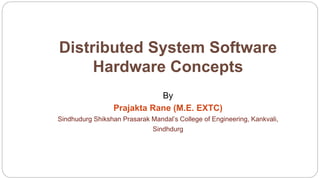
2. Distributed Systems Hardware & Software concepts
- 1. Distributed System Software Hardware Concepts By Prajakta Rane (M.E. EXTC) Sindhudurg Shikshan Prasarak Mandal’s College of Engineering, Kankvali, Sindhdurg
- 2. Distributed System Hardware Concept Two Types 1. Multiprocessor System 1. Private Memory Architecture 2. Shared Memory Architecture 2. Multicomputer System
- 3. Distributed System Software Concept The software of the distributed system is nothing but selection of different operating system platforms. The operating system is the interaction between user and the hardware. There are three largely used operating system types: a) Distributed operating system b) Network operating system c) Middleware operating system
- 4. Distributed operating system: It is different from multiprocessor and multicomputer hardware. Multiprocessor- uses different system services to manage resources connected in a system and use system calls to communicate with the processor. Multicomputer- the distributed Operating system uses a separate uniprocessor OS on each computer for communicating between different computers. In distributed OS, a common set of services is shared among multiple processors in such a way that they are meant to execute a distributed application effectively and also provide services to separate independent computers connected in a network as shown in fig below It communicates with all the computer using message passing interface(MPI). It follows the tightly coupled architecture pattern. It uses Data structure like queue to manages the messages and avoid message loss between sender and receiver computer.
- 5. Disadvantages: It has a problem of scalability as it supports only limited number of independent computers with shared resources. There is need to define message passing semantics prior to the execution of messages.
- 6. Network operating system: It is specifically designed for heterogeneous multicomputer system, where multiple hardware and network platforms are supported. It has multiple operating system running on different hardware platforms connected in network. It provides to each computer connected in network. It follows the loosely coupled architecture pattern which allow user to use services provided by the local machine itself as shown in fig below. Eg Remote login where user workstation is used to log in to the remoter server and execute remote commands over the network. Eg Centralized file storage system. Advantage: It has scalability feature, where large number of resources and users are supported. Disadvantage: It fails to provide a single coherent view.
- 8. Middle ware operating system: As distributed operating system has lack of scalability and network operating system fails to provide a single coherent view, therefore a new layer is formed between the distributed and network operating system is called the middleware operating system. It has a common set of services is provided for the local applications and independent set of services for the remote applications. It support heterogeneity that is it supports multiple languages and operating system where user gets freedom to write the application using the any of the supported language under any platform. It provide the services such as locating the objects or interfaces by their names, finding the location of objects, maintaining the quality of services, handling the protocol information, synchronization, concurrency and security of the objects etc.
- 10. Models of Middleware Remote Procedure call: It is one of the succesful middle ware models used in modern distributed applications for communication. It uses local call to call a procedure resides on the remote machine to get the result. Hidden communication is done between client and server. For eg If a user wants to get the sum of two numbers stored on remote server by using local method call, the user calls method with parameters, in turn server receives a RPC call from the client and returns the appropriate result to the client. Therefore, though the method was executed remotely it appears like a local to the called machine. This is a synchronous technology where both the client and server should be present during the communication.
- 11. Remote Method Invocation In this objects are distributed and located by using the RMI registry. The client can access remote objects by using the interfaces. Disadvantage It didnt support the concept of hetrogeneity and is compatible with java platform only. Common object request broker architecture(CORBA)- It is one of the most popular distributed object technologies where objects can be accessible from remote location through ORB. Server and client communicate with each other through object request broker bus. To map the semantics of objects and fetch the appropriate object an interface definition language is used. It is evolved with service based middle ware where service models are used. In service model, the services are published by the service providers and consumed by the service consumer. eg Service oriented Architecture (SOA)
- 12. Distributed Object Technology The distributed object technology has changed the scope of middleware technologies to one step up where objects are distributed to the remote server to facilitate the client. Eg RMI and CORBA The distributed object mechanism hides the communication interfaces and their details to provide access to the remote object efficiently.
- 13. Message oriented Middleware(MOM): It is another model used to send and receive the communication messages between clients and servers. It uses data structures like queue to store and retrieve messages. When the client is sending the messages faster than the receiver receiving it or the client is sending the message when the receiver is not available. So it uses queuing mechanism between the client and server to avoid the message been misplaced. It is asynchronous mechanism where messages can be sent even though the receiver is not available For eg Email system
- 14. Services offered by Middleware System Naming service-used to locate objects/interfaces Persistence service- used to store distributed objects permanently on to data store Messaging service – used to send or receive messages in terms of request response primitive Querying service – used to query on distributed objects Concurrency service - used to share and access the resources concurrently Security service- used to provide security to the various shared resources